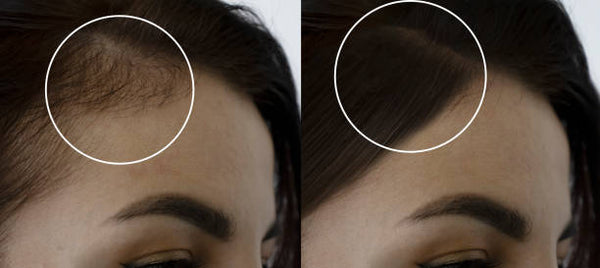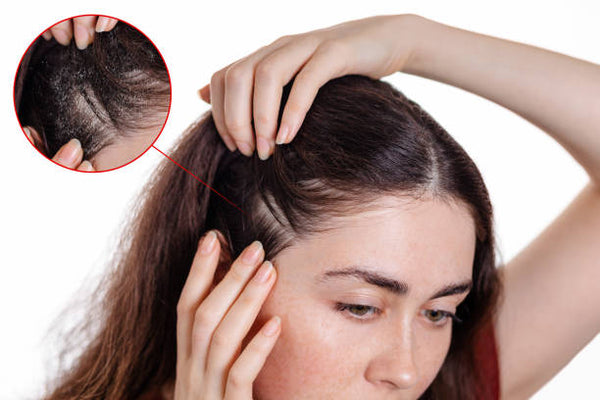The Relationship Between Estrogen Deficiency and Hair Aging

Estrogen plays a vital role in maintaining the health and vitality of hair. However, as women age and experience hormonal changes, particularly during menopause, the decline in estrogen levels can significantly impact hair health. Estrogen deficiency accelerates common signs of hair aging, such as thinning, graying, and fragility, by weakening hair bonds and reducing follicular activity. Understanding this relationship is essential for addressing hair aging and implementing targeted solutions that support bond repair and rejuvenation.

How Estrogen Affects Hair Health
-
Promotes Hair Growth Cycles
Estrogen helps maintain the hair growth (anagen) phase by stimulating hair follicles, ensuring consistent growth and fullness. -
Strengthens Hair Bonds
Estrogen supports keratin production, fortifying the structural bonds of each hair strand and reducing the risk of breakage. -
Regulates Scalp Sebum Production
By balancing scalp oil production, estrogen helps maintain a healthy scalp environment, preventing dryness or excess oiliness that can weaken hair. -
Delays Signs of Aging
Estrogen’s antioxidant properties help combat oxidative stress, delaying graying and preserving hair elasticity and shine.
The Impact of Estrogen Deficiency on Hair Aging
-
Thinning and Hair Loss
Estrogen deficiency shortens the anagen phase, leading to reduced hair density and thinning over time. -
Weakened Hair Bonds
Lower estrogen levels diminish keratin production, compromising the integrity of hair bonds and making strands more prone to breakage. -
Accelerated Graying
Estrogen loss exacerbates oxidative damage to hair follicles, speeding up the depletion of melanin, the pigment responsible for hair color. -
Increased Fragility
Without the protective effects of estrogen, hair becomes brittle, losing elasticity and strength.
Benefits of Bond Repair Treatments for Estrogen-Deficient Hair
-
Restoring Structural Integrity
Bond repair treatments strengthen weakened hair bonds, counteracting the fragility caused by estrogen loss. -
Replenishing Lost Moisture
Hydrating treatments combat the dryness that often accompanies hormonal changes, improving hair resilience and manageability. -
Preventing Further Damage
By protecting hair from oxidative stress and environmental factors, bond repair treatments prevent accelerated aging. -
Improving Elasticity and Shine
Targeted solutions smooth the hair cuticle, restoring the elasticity and luster often lost with age.
Key Ingredients for Supporting Estrogen-Deficient Hair
-
Keratin for Bond Strength
Keratin rebuilds weakened hair bonds, restoring structural integrity and reducing breakage. -
Collagen for Elasticity
Collagen enhances hair’s elasticity and combats brittleness, improving its overall texture and strength. -
Hyaluronic Acid for Hydration
Hyaluronic acid locks in moisture, preventing the dryness and fragility often associated with estrogen deficiency. -
Antioxidants for Protection
Ingredients like vitamin E and green tea extract neutralize oxidative stress, preserving hair color and health. -
Plant Phytoestrogens
Compounds found in soy or red clover mimic estrogen’s effects, supporting hair follicle activity and delaying aging.
How Bond Repair Treatments Counteract Hair Aging
Estrogen deficiency causes significant damage to hair bonds, making them weaker and more susceptible to external stressors. Bond repair treatments work at a molecular level to restore strength, hydration, and vitality, addressing the root causes of hair aging.

Enhancing Bond Repair Results for Aging Hair
-
Deep Hydration for Strengthened Bonds
Bond repair treatments enriched with humectants and oils replenish moisture, improving the resilience of hair bonds. -
Protection from Oxidative Damage
Antioxidant-infused treatments shield hair bonds from free radical damage, preserving their integrity. -
Elasticity Restoration
Collagen and keratin work together to rebuild elasticity in aging hair, minimizing brittleness and breakage. -
Long-Term Nourishment
Regular use of bond repair treatments ensures continued support for aging hair, maintaining its health and vitality over time.
FAQ
-
How does estrogen deficiency affect hair bonds?
Estrogen deficiency reduces keratin production and increases oxidative stress, weakening hair bonds and making strands more prone to damage. -
Can bond repair treatments reverse the effects of hair aging?
While they cannot reverse aging, bond repair treatments can significantly improve the strength, elasticity, and hydration of aging hair, restoring its appearance and manageability. -
Are plant-based phytoestrogens effective for hair aging?
Yes, phytoestrogens can mimic estrogen’s effects, supporting follicular activity and delaying signs of hair aging. -
What ingredients should I look for in bond repair treatments for aging hair?
Ingredients like keratin, collagen, hyaluronic acid, and antioxidants are particularly effective for repairing and protecting aging hair bonds. -
How often should I use bond repair treatments for aging hair?
For best results, use bond repair treatments weekly, complementing them with hydrating and antioxidant-rich products for daily care.
By addressing the structural and environmental challenges associated with estrogen deficiency, bond repair treatments and targeted ingredients help restore strength, elasticity, and shine to aging hair.



